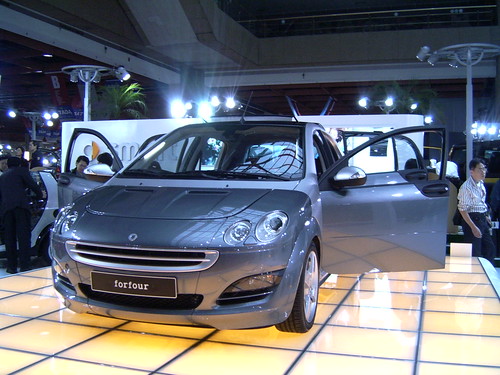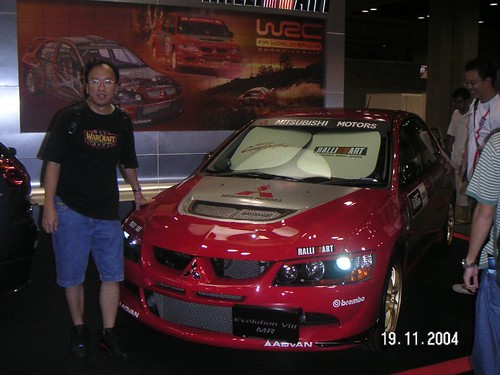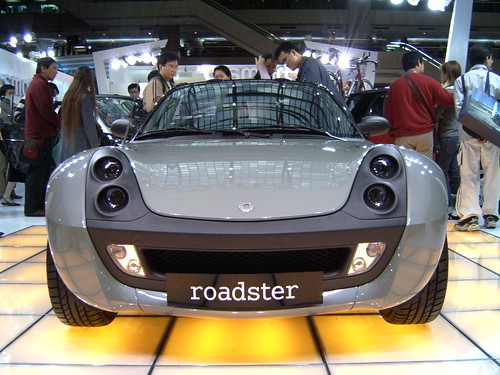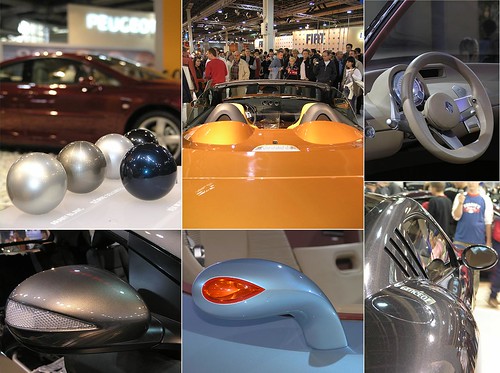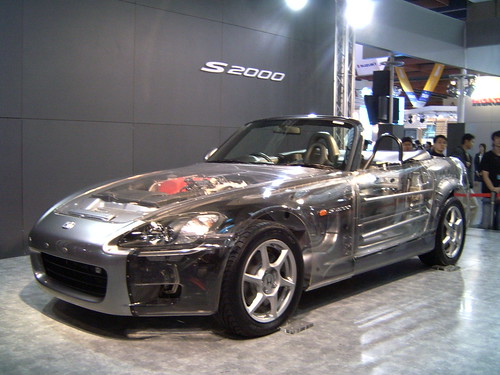Saturday, October 20, 2007
Friday, October 19, 2007
2007 Nissan Round Box Concept

- Four-seat convertible roadster
- "Environmentally friendly" direct-injected turbo four-cylinder
- Uses Nissan's Xtronic CVT technology
- Rounded, boxlike shape (go figure)
- Three-section, removable roof panel that stores in trunk
- Small glass windows near rocker panels that provide a view of whizzing-by ground
Nissan says: "The car was inspired by the lively atmosphere of a sports bar. In a sports bar, everyone is focused on the game...and free of the tension felt by the players. A sports bar affords an affordable, stress-free space where friends can experience a sense of togetherness. Simultaneously, they can enjoy thrilling excitement like being on a roller coaster, yet without any risk involved. That is the sort of emotive world the Round Box is intended to provide."
We say: It may look like a Smart car sitting on a skateboard, but the Round Box represents an attempt to provide ecologically conscious, efficient, and safe transportation that actually has an element of fun about it. The idea of doing more with less - less weight, less power, less overall interior volume - in a unique and oddball fashion has long been a Tokyo show hallmark, and the Round Box is no different.
What separates it from the usual Tokyo field of never-gonna-build-it rolling gel balls and funky wheelomat funtime machines? Realism. The Round Box actually looks like something that might roll off a production line one day, and its fundamental ethos - that the sensation of speed and a shared experience is vital to behind-the-wheel enjoyment - is a valid one. We wouldn't be surprised if further iterations of the Round Box's basic idea populate future auto shows.
On the other hand, based on Nissan's statement, the Japanese company wants driving to be a safe, risk-free, perpetually insulated experience, one you may as well be watching on TV. Sounds like fun. Really. We mean it.
By Sam Smith



2007 Nissan NV200 Concept

- Cargo-van-meets-rolling-office
- Extendable rear pod enlarges rear work area at will
- Not a new concept; similar setups have been seen before on a number of recent concepts
- Unique execution: Pod can be removed from van to sit on extendable legs when parked
- With pod withdrawn, area left behind can be transformed into mobile office and IT dock
- Environmentally friendly clean-diesel engine
- Designed with help from (and specifically for) world-renowned marine biologist and underwater photographer Dr. Alex Mustard (Just don't call him "Mister.")
Nissan says: "A commercial vehicle has a specific job to perform, but that's no reason to design a purely rational vehicle with no warmth. In NV200, function becomes the aesthetic. NV200 is a highly efficient tool but one with a human touch. Nissan prides itself on designing its cars to fulfill the needs and requirements of its customers. For NV200, we have taken that guiding principle quite literally and created a vehicle for one specific customer."
We say: The NV200's press release is filled with comments from Dr. Mustard on how the vehicle would suit his needs, but if you're not a marine biologist-slash-underwater photographer, don't despair. The NV2000 actually has a fair number of innovative features and tiny touches (the removable pod is just the tip of the iceberg), things like hidden tent storage, movable stow boxes, and a matching docked laptop. Solar panels on the roof and a generator power the computer, a shower, a refrigerator, and other attached electrical knicknacks. In other words, regular people can actually make some use of it. Like the Round Box, the NV2000 isn't a unique concept -- from Airstream to Ford, almost everyone has done the lab-on-wheels idea before -- but it's well executed, and could work in a large variety of situations and environments.
By Sam Smith


2007 Nissan Intima Concept

- V-6 diesel engine
- Suicide doors that open almost 180 degrees, no B-pillar
- Windshield and glass roof formed from a single glass panel
- Floating, curved-wood console
Nissan says: "The inspiration came from imagining a situation where a person who has accumulated many life experiences and successes now wants to spend his or her own time, or time together as a couple, in an elegant environment."
We say: This sleek, four-seat sedan emphasizes interior design, but given that its exterior dimensions are within spitting distance of the current Maxima's (less than 2 inches longer overall and riding on the same, 111-inch, wheelbase), we wonder if the Intima also provides an early look at the styling of the next-generation Maxima. If so, we would advise Nissan not to drop the Maxima name; Intima sounds like a brand of condoms.



writer: Joe Lorio
2007 Mitsubishi i MiEV SPORT Concept

- Variant of the previous i Miev electric-car concept
- 2+2 seater
- Claimed 124-mile driving range
- In-wheel electric motors for the front wheels, one motor for the two rear wheels
- Batteries supplemented by a photovoltaic generator on the roof, regenerative brakes, and a power-generating fan inside the grille
Mitsubishi says: "The car brings a new closeness between people and cars; allowing them to become more a part of daily life."
We say: Tiny electric cars are a fixture of the Tokyo show. The i MiEV SPORT at least innovates with is supplemental power generators. We also like its slope-backed shape more than that of its plain-looking four-door predecessor.
writer: Joe Lorio



2007 Honda Puyo Concept

- Rounded shape is supposed to be pedestrian-friendly
- Body is made of a soft gel rather than sheetmetal
- Scissor doors, all-glass canopy
- Lights glow through the gel panels
- Joystick replaces steering wheel
- Powered by a hydrogen fuel cell
- Minuscule size, yet seats four
Honda says: "Puyo is a Japanese word that embodies the tactile traits of this unique car. Puyo is meant to convey all that is warm and friendly, and put a smile on the face of users and pedestrians."
We say: The tiny cube shape has been the all the rage at this show for a while (and more so this year than ever), but the Puyo still contains plenty of bizarre yet intriguing totally out-there thinking, which is exactly what we love about the Tokyo show.



writer: Joe Lorio
Thursday, October 18, 2007
2009 Jaguar XF-writer: Gavin Conway

Jaguar fans have always been vocal and opinionated about what sort of cars Coventry should be building. Their opinions usually boil down to "make it breathtakingly beautiful, with loads of performance."
With Ian Callum - the design genius behind such great cars as the Aston Martin DB7 and DB9 - now at the Jaguar styling helm, the "breathtaking" part should have been a walk in the park. But there's a contingent within Jaguar that insisted that the XF, which replaces the S-type and needs to sell in big numbers, should also be class-competitive with the likes of the Audi A6 and the BMW 5-series. That means the XF had to have a big trunk and space for five adults, but it also meant a little less freedom to create a truly stunning visual form.
The XF looks a lot like a Lexus GS in profile. That's no bad thing, but the XF hardly provides the drama that you'd expect from the brand that created the original XJ in the 1960s. The overall visual impression you get from the XF is that it's nice but not stunning. It has some really good detailing, such as the chrome strip at the back that sweeps under the taillight cluster and its complex headlamps. But Jaguar has attached a large chrome "leaper" on the trunk lid because, as insiders admit, most onlookers won't know that it's a Jag otherwise.
On a more positive note, the XF's interior really scores - there's plenty of room to seat four large adults in comfort. The cabin overflows with neat details, such as the gear shifter, covered HVAC vents that rotate to open, a start button that pulses red when you enter the car, and blue lighting around the instruments and dials. And the quality of materials and assembly on the XF we recently saw at Jaguar's design studio was as good as anything in the class. The XF's long list of electronic driver aids also is competitive and includes voice control for audio and telephone, a blind-spot monitor, adaptive cruise control, a tire-pressure monitor, and an electronic parking brake.
At launch, the XF will be available with Jaguar's familiar 4.2-liter V-8 in either normally aspirated or supercharged guise, developing 300 and 420 hp, respectively. A six-speed automatic with shift paddles will be standard. Jaguar isn't yet using the R badge-denoting the highest-performance model in the range-for the 420-hp supercharged XF. That will come later, when the XFR launches with 500-plus hp.
In the meantime, we'd really like to see Jaguar succeed with this new sedan. And while it's good that the brand is abandoning retro pastiche design, we wonder whether the XF has pushed Jaguar's new look far enough.
Be sure to see our photo gallery (below) for three pages of wallpaper-quality images of the new XF!
Driven! Volkswagen GTI W12-650 - by Georg Kacher

The hand-written notes compiled by the pit crew are littered with bad news.
Lap one, DNF. Car spins out in turn two.
Lap two, DNF. Car spins out in turn two. Needs to be towed back or jump-started.
Are they letting any idiot with a valid driver's license behind the wheel of this hand-built prototype valued at several million dollars?
What's wrong with you today, George? Hung over? Legs trapped in the footwell again? Or are you simply getting old?
Well, yeah. But the only real mistake I made was not asking enough questions before strapping myself behind the fancy three-spoke sport steering wheel.
I expected the VW crew to provide all the relevant information. Wishful thinking. Being the last out of maybe twenty journalists to be shuttled through this program, it was routine for them - but not for me.
They knew that the surface of the race track at Gross-Dlln near Berlin is covered with a low-grip asphalt film so that a set of tires last about five times longer. But didn't tell me.
They knew that the shift paddles behind the steering wheel spokes of the prototype are still functionless. But didn't tell me.
They knew that the ESP switch is only there for decoration. ESP and ASR are both conspicuous by their absence. Yeah, they didn't tell me this either.
I set off as clueless and enthusiastic as a Labrador Retriever. First, second, third -- not flat-out but perhaps an optimistic 80 percent throttle. You don't want to look too slow, do you?
But whatever the entry speed into turn two was, it was about 40 percent more than what the pale grey surface would tolerate. Whoops. Spin.
Never make the same mistake twice, or you really look like a bozo.
So, next time, it's first, second and third again, then a pause, getting ready to downshift and turn in. Downshift? DOWNSHIFT! I pulled the paddle - repeatedly - but it did nothing. Remember, I didn't know that it wasn't connected. I blame the car. Yeah, the car! Lift-off inertia grabs the car's midriff where the mighty engine dwells, and this time we don't just spin once. We spin twice, loop-di-smoking-loop.
Face lobster red, I reach for the ignition key. Dead. Try again. Dead.Lights off, ventilation off, try again. Dead. The only items that are still running at full whack and full volume are the two giant fans that try to keep the W-12 from exploding or imploding or melting down for good.

From the distance, a green Volkswagen van approaches. Exeunt three, four, five VW specialists gloating with a mix of malicious delight and sheer disbelief.
Ten minutes later, both parties know the truth. Which is that the battery has been wired to feed only the fans, not the starter; ESP exists in the head of the senior electrician but not yet in the car; and Gross-Dlln is famous for its ice rink characteristics, not for grip and traction.
We mutually agree to forget what just happened, to give me a second chance, and to bring this baby home safe and sound and undamaged. I promise and cross my fingers.
This time it works. I keep it on the track. This time, red-flagging the white GTI to call it a day won't do. Oh no. This time, they'll need to physically block my path. Which they do, and by the time they pull me out of the car, I look and smell like a drenched wharf rat.
Make that a happy drenched wharf rat. This GTI, boys, is better than a night in Nymphetteville. Better than two bottles of vintage 2000 Brunello.
Probably even better than a splash-and-dash bungee jump, although come to think of it, perhaps not.
The flicker in my eyes didn't go away for days. And my dreams definitely no longer revolve only around that dinner date with Nicole Kidman. You know, the one that'll never happen.
Theoretically, the big white GTI is good for 203 mph. The main runway of Gross-Dlln, which once was East Germany's main military airport, is theoretically long enough to attain 203 mph. I know it, because I did over 200 mph there in the Porsche Carrera GT. But the W12-650 show car is restricted to 124 mph. Does it matter? Not really - it was more than enough speed for me to spin it. And, more importantly, because the surface deteriorates quickly when you spin off the pavement after the final left-hander.
First, it's just gravel and sand. Then it's gravel and sand and vegetation.
Eventually, you start counting rabbits on the left and deer on the right, not to mention half a dozen buzzards practicing take-off and landing.
So we stick to the track, which looks like sandpaper but feels like liquid soap. Since you run out of third at the end of the longest non-wriggly bit, 113 mph is Vmax. Not a lot by race car standards, but bloody quick for an experimental vehicle that will in all likelihood never make it into production. Ignore the shift paddles, that's what they had said. Use the gear lever in Tiptronic mode instead. Sure, no prob, everything roger and cool.

For about ten laps, the car works perfectly. Then the bug that seems to live inside this wild GTI-on-steroids finally reaches the transmission. From now on, it's say a prayer and hope for the best. Upshifts happen as they should, but downshifts sometimes happen, sometimes don't. Sometimes they need two or three attempts; sometimes you go from four to two in one shrieking high-rev lesson.
Are the instruments on top of the dashboard really displaying boost pressure and exhaust temperature? Or are these needles reflecting the driver's pulse and blood pressure? Thump, thump, thump. Never mind. Here we go again.
2008 Mitsubishi Lancer Evolution X-By Sam Smith

Grins. Snorts. Laughter. Armloads of steering lock, great gobs of throttle, and even more laughter. We slide sideways through an enormous pile of cast-off rubber--marbles--and come to a stop, laughing, inches from a pair of yellow slalom cones.
"Ackthph!" says my passenger, enveloped in a translucent cloud of black dust. "I can taste the tires."
We are at an autocross course at Mitsubishi's Tokachi Proving Ground, on the northern Japanese island of Hokkaido. This is the middle of nowhere. I am attempting to convince a preproduction Mitsubishi Lancer Evolution X that I am the world's most talented drifter, but the car isn't buying it; every half lap, I dissolve into helpless laughter and go spinning off into cone-mauling oblivion. Every so often, I force myself to stop cackling and pull things together for a clean, fast, drift-free run--but those are depressingly easy by comparison. They're also a lot less entertaining.
Next run. Flick--I throw the wheel right and pop my foot off the throttle. As the back end jinks out, I wind the wheel into the slide and watch the world come at me through the side window. More throttle: the front end claws us back into line, and we crisply rocket off toward the next slalom. The grin might as well be painted onto my face.

On dry pavement, unmodified all-wheel-drive street cars aren't supposed to be this much riotous, opposite-lock fun. Furthermore, bigger, plusher updates of stripped-out rally rockets aren't supposed to upstage their lighter, smaller, and rowdier predecessors. But therein lies the key: the 2008 Lancer Evolution X is a far better car than most people expect it to be.
Although there have been ten incarnations of the Lancer Evolution--the X in the Evo X's name represents the Roman numeral ten and not the letter X--the Lancer sedan upon which it is based has undergone only four generational changes since its inception. The most recent of the four gave birth to the 2003-07 Evo VIII and Evo IX; that platform was the first Evolution-spec Lancer to come to the United States. As you'd expect, it was also the best-selling of the bunch, clocking in at about 60,000 examples worldwide. (To put that figure into perspective, consider that Evos I through VI sold fewer than 60,000 units combined.)
The latest Lancer Evolution represents a hefty break from tradition. The age-old, tacked-together Evo styling ethos has been replaced by a much more cohesive, ground-up approach. Gone, too, is the legendary iron-block, 2.0-liter turbocharged four-cylinder that powered all nine previous Evos. An all-new, aluminum-block, 2.0-liter turbo four with 295 hp and 300 lb-ft of torque produces both more grunt and more power than its predecessor. For the first time ever on an Evolution, a two-pedal, twin-clutch automatic transmission is available. And, most important, the once rough-and-ready Evo appears plumped out, comfy, and option-laden at first sight--or, to the layman, a great deal more like a Real Car.
For those who have been paying attention, such drastic changes are not surprising. Mitsubishi Motors has been bleeding red ink for the past decade, and the Lancer Evo, in all its forms, has long been the sole star in the company's firmament. A global car manufacturer cannot survive on one cult model, however successful, and Mitsubishi knows it.

That's why the Lancer Evo is such a changed beast. The Evolution X is a make-or-break car for Mitsubishi, created with the primary goal of jump-starting sales and boosting the brand into more widespread commercial success. Naturally, such an approach can backfire: broader appeal equals diluted focus equals a car that isn't as fantastic from behind the wheel. And so, wary of such things, we traveled to Japan to drive a preproduction, Japanese-market Evo X. We arrived full of doubt and curious as to just how much--if any--of the classic Evo charm was left.
In the remote wooded hills and relative tranquility of Tokachi, away from the distraction of urban Japan, the Lancer Evo's new personality hits you like a smack in the face. Parked next to an Evolution IX, the Evo X appears larger, more serious, and altogether less friendly than its older, iconic brother. Even the harmless little NACA duct on the hood seems to sneer at you derisively.
Certain Evo features are considered perennial. Aluminum fenders, hood, and roof panels are all stock (so long as you don't order a sunroof; that option requires a steel roof panel). Massive brakes--13.8- and 13.0-inch Brembo rotors in the front and the rear, respectively--are standard across the lineup. And sitting on the dash, right where you'd expect it to be, is a switch for the all-wheel-drive system's available traction modes (Snow, Gravel, and Tarmac, naturally).
At the same time, little has changed in the suspension department. The strut-type front and multilink rear setup used on the Evolution IX carries over, albeit with revised geometry, strengthened front struts, and more rigid hubs. The base Evo now wears a GSR suffix, while an MR model is again available and adds suspension upgrades including Bilstein shocks, Eibach springs, and eighteen-inch BBS wheels.
Ferrari 612 Scaglietti

The Ferrari 612 Scaglietti features a Manual transmission and Rear Wheel Drive drivetrain on the base model 612 Scaglietti. The 2007 base model has an MSRP of $255,519.00 which is well within the range of most car buyers. However, don’t let the great retail price be your only deciding factor. At Automobile Magazine you’ll get all of the information you need to help with your car buying decision. Whether you are looking for interior and exterior car photos, engine options, or safety ratings, just
Type
Base
MSRP : $255,519.00
Transmissions: Manual
Drivetrains : Rear Wheel Drive
F1
MSRP : $267,887.00
Transmissions: Semi-Automatic
Drivetrains : Rear Wheel Drive
Ferrari 599 Overview

The Ferrari 599 features a Manual transmission and Rear Wheel Drive drivetrain on the base model 599. The 2007 base model has an MSRP of $264,034.00 which is well within the range of most car buyers. However, don’t let the great retail price be your only deciding factor. At Automobile Magazine you’ll get all of the information you need to help with your car buying decision. Whether you are looking for interior and exterior car photos, engine options, or safety ratings, just select the vehicle trim The Ferrari 599 features a Manual transmission and Rear Wheel Drive drivetrain on the base model 599. The 2007 base model has an MSRP of $264,034.00 which is well within the range of most car buyers. However, don’t let the great retail price be your only deciding factor. At Automobile Magazine you’ll get all of the information you need to help with your car buying decision. Whether you are looking for interior and exterior car photos, engine options, or safety ratings, just select the vehicle trim on the left to begin researching your next new car. We are constantly updating our information so be sure to check back often to see if new information has been posted for your favorite car. Enjoy the wide-ranging car facts in our buyers guide and when you’ve narrowed down your decision, take a couple minutes to get a free new car price quote. There is no pressure to buy but you can see what kind of deals may be offered in your area.
Subscribe to:
Posts (Atom)
